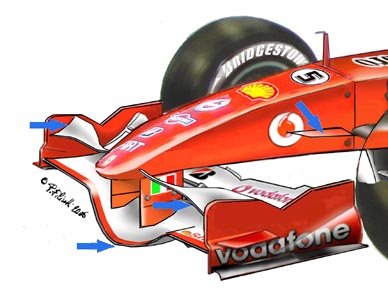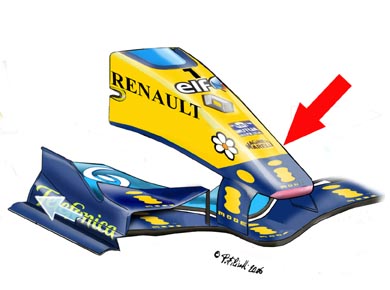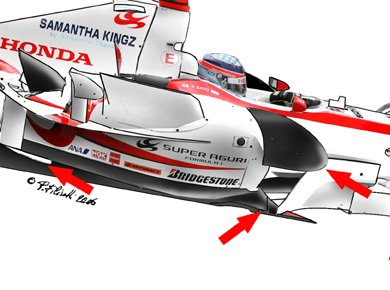Wednesday, March 15, 2006
F1: Technical Analysis - Grand Prix - Bahrain

Part of Ferrari's revised aero package for Bahrain. The endplates previously sported large slits in their upper section. Now they have small ones in their lower section instead, complete with small, upward-curving fins. The function is similar to before - to reduce turbulence generated by the rear wheels, by helping the boundary layer of airflow passing between the wing and the endplate to detach more quickly, hence cutting drag.
For Bahrain, the 248 F1's front wing features a deep-spoon shape in the centre of the main profile, replacing the additional box wing seen below last year's nose. To make what is effectively a double-decker wing, this is coupled with two additional profiles connected to the endplates either side on the nose cone. The endplates themselves are different - the front section of their top edges are now almost flat, not steeply angled as before. Finally, a small fin is added either side of the nose, just in front of the suspension's upper wishbone pickup point. This acts as a stabliliser and airflow splitter, reducing turbulence in this area.
It is interesting to note that sometimes teams adopt solutions no longer used by the team that originally introduced them. Red Bull's current V keel is one example. The wide nose on the Renault is another. A very similar one was used by McLaren last year, but abandoned in favour of a much narrower design for the latest MP4-21. The advantage of a wide nose section is related to the potential increase in downforce generated by the larger surface area.
After proving its worth on the Renault R25 last year, Red Bull have adopted a V keel solution for 2006. The solution is particularly good - when coupled with the RB2's high nose - at improving aero efficiency in the area under the chassis close to the splitter. The airflow encounters less interference with the V keel, even if it is not quite as efficient as the no-keel concept introduced by McLaren last year and now seen on several 2006 cars.
Kimi Raikkonen was last on the Bahrain grid thanks to a right lower wishbone failing on his rear suspension during qualifying. There are no heavy suspension loads or high kerbs at Sakhir and the failure was down to a manufacturing fault. It does, however, draw attention to the extreme design of components on the MP4-21, with the dimensions of many reduced to the maximum in a bid to save weight and minimise any negative impact on the car's aerodynamics.

This car may be based on a 2002 Arrows, but in Bahrain it was already showing aero developments not dissimilar to features seen on other 2006 cars. The sidepods shrink under the body and sport a huge winglet at the front, resembling that on the Honda RA106 (right arrow). At the rear there is a large flip-up with a pillar connecting it to a smaller, secondary flip-up (left arrow). The barge boards have also been revised, with small fins at their lower edge (centre arrow) to improve airflow management under the car.